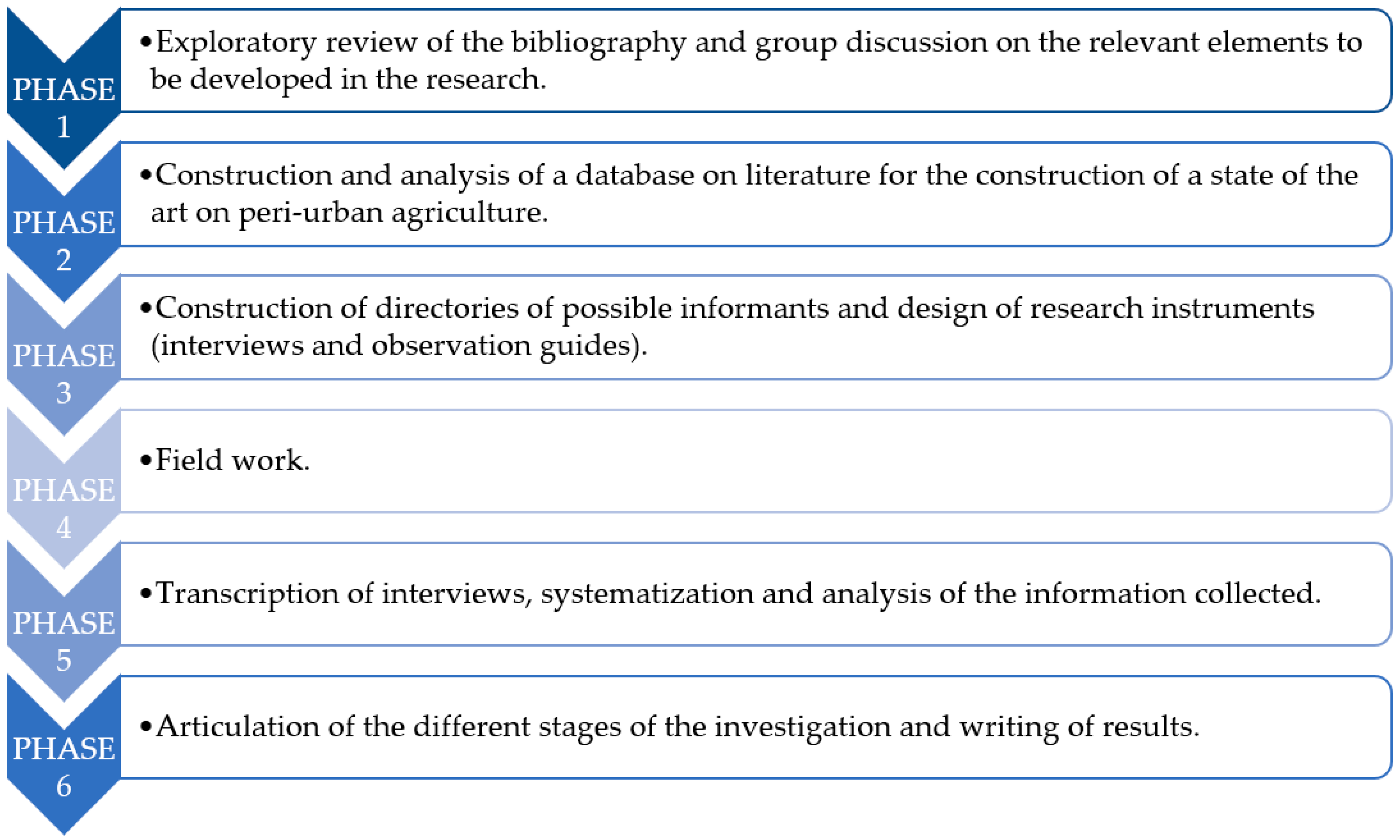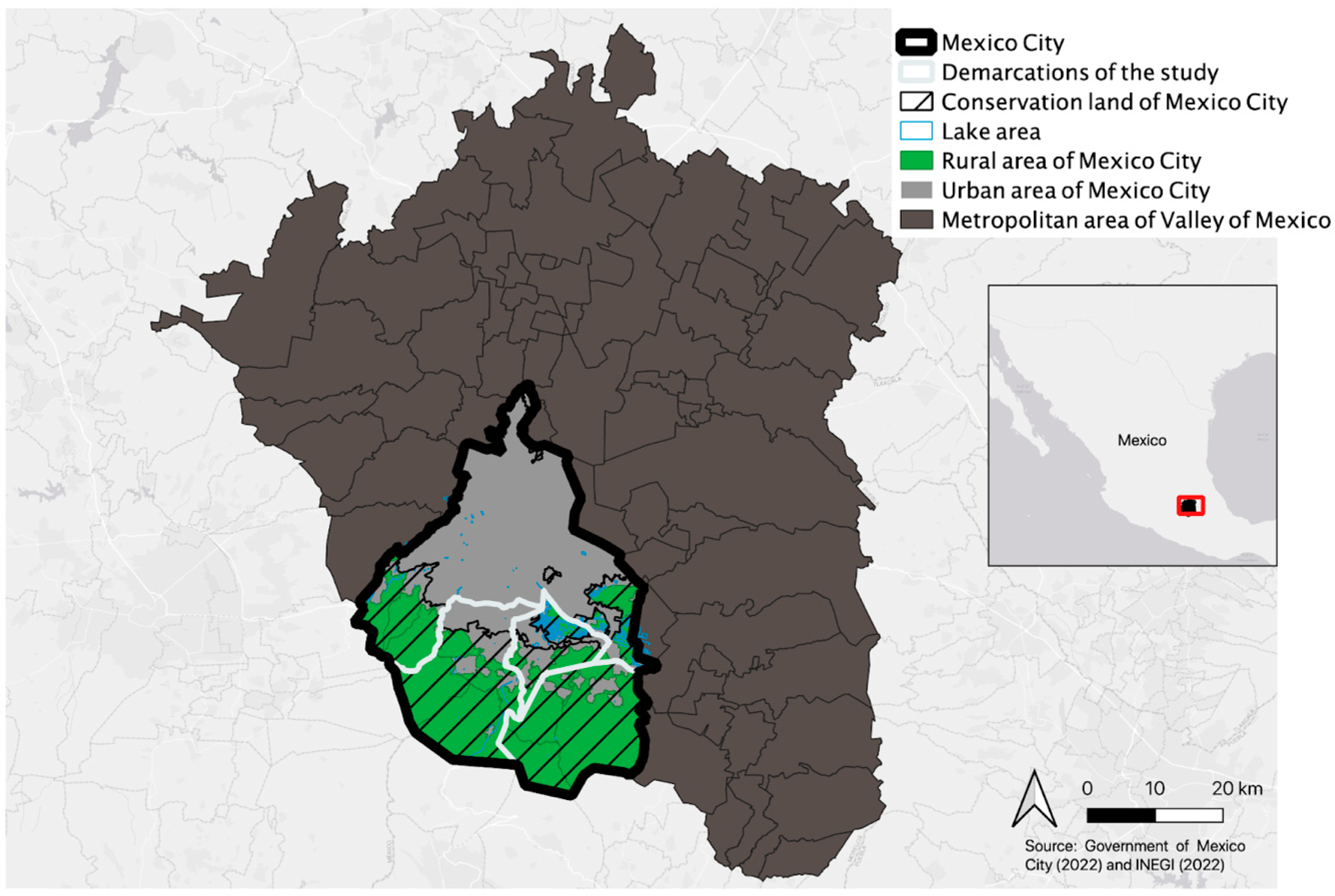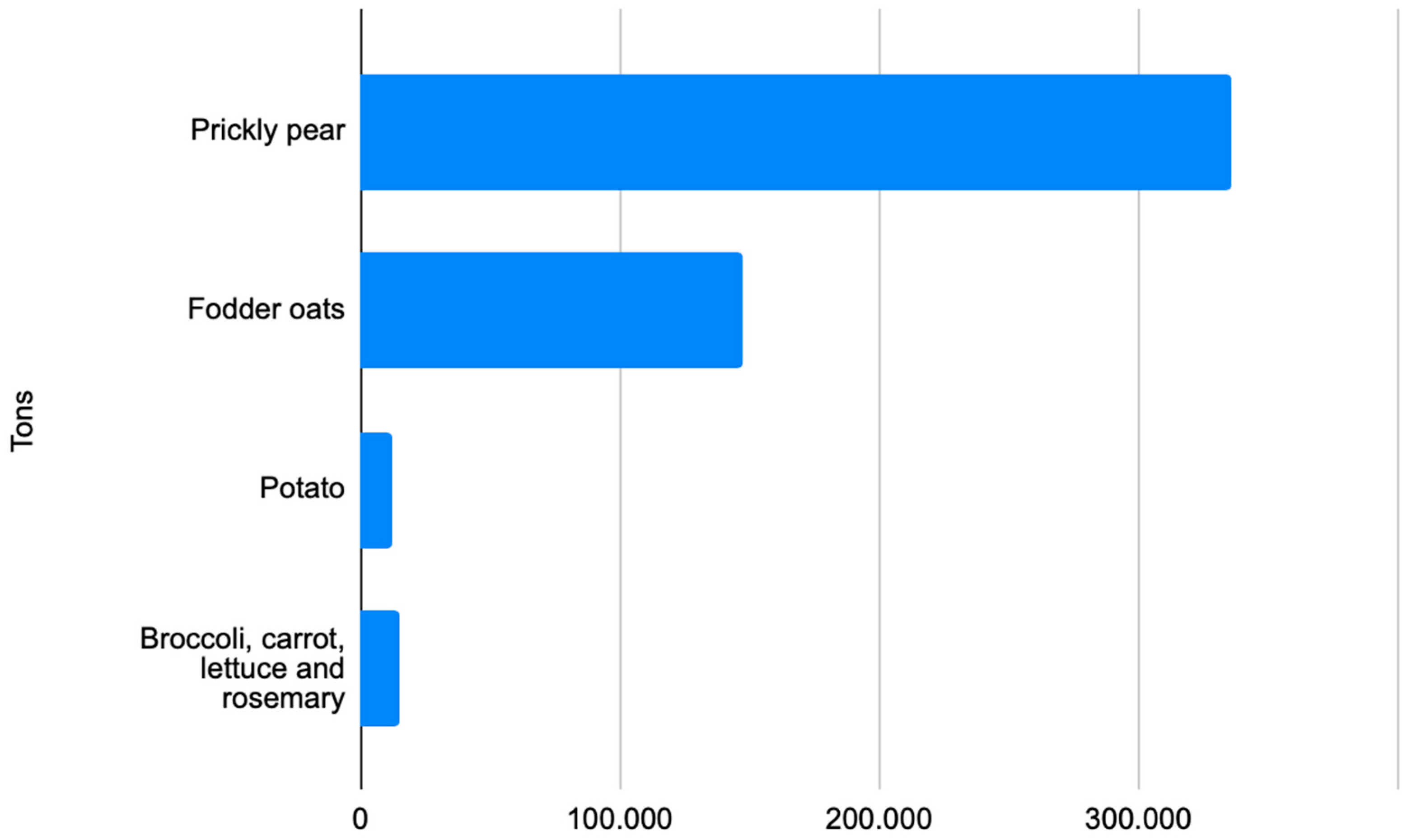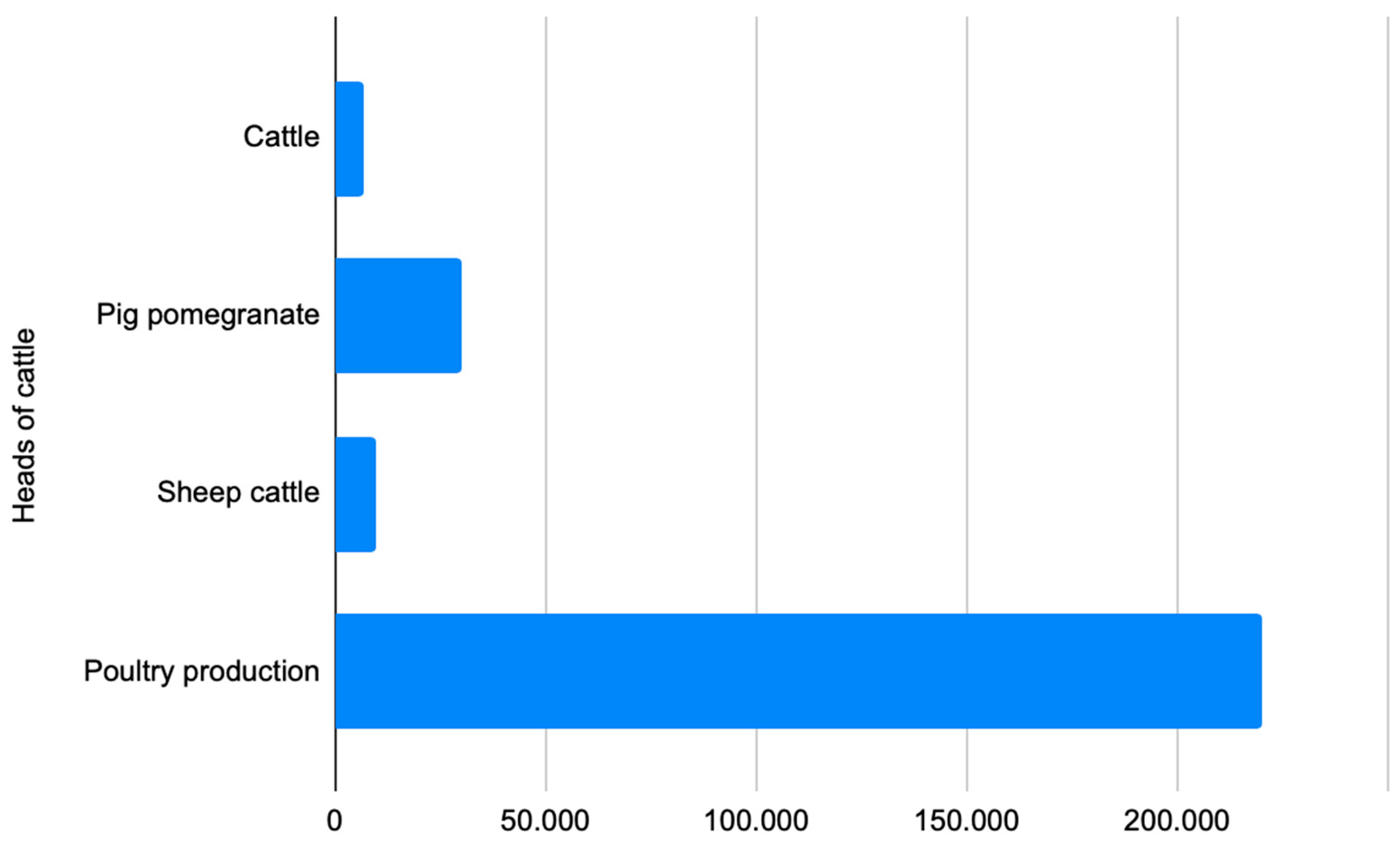Food Producers in The Peri-Urban Area of Mexico City. A Study on the Linkages between Social Capital and Food Sustainability
Abstract
1. Introduction
2. Materials and Methods
3. Results
3.1. Peri-Urban Agriculture in Mexico City
3.2. Description of Typology and Relationship with Social and Cultural Capital
3.2.1. “Traditional” Peri-Urban Agriculture
3.2.2. “Traditional-Innovative” Peri-Urban Agriculture
3.2.3. “Politicized Projects”
3.2.4. “Educational/Tourism Projects”
3.2.5. “Business Projects”
4. Discussion
5. Conclusions
Author Contributions
Funding
Institutional Review Board Statement
Informed Consent Statement
Data Availability Statement
Acknowledgments
Conflicts of Interest
References
- IPES FOOD. The New Science of Sustainable Food Systems: Overcoming Barriers to Food Systems Reform. In First Report of the International Panel of Experts on Sustainable Food Systems 2015; IPES Food: Brussels, Belgium, 2015. [Google Scholar]
- FAO. Marco Estratégico de la FAO para 2022–2031. 2022. Available online: https://www.fao.org/strategic-framework/es (accessed on 5 September 2002).
- Poulain, J.P. Biodiversity, Ethno-Diversity and Food Cultures: Towards more Sustainable Food Systems and Diet. In Local Food Plants of Brazil; Springer: Berlin/Heidelberg, Germany, 2021; pp. 19–28. [Google Scholar] [CrossRef]
- UNEP. Food Systems and Natural Resources Resource Panel; United Nations Environmental Programme: Nairobi, Kenya, 2016. [Google Scholar]
- Mancini, M.; Arfini, F.; Antonioli, F.; Guareschi, M. Alternative Agri-Food Systems under a Market Agencements Approach: The Case of Multifunctional Farming Activity in a Peri-Urban Area. Environments 2021, 8, 61. [Google Scholar] [CrossRef]
- Nicholls, E.; Ely, A.; Birkin, L.; Basu, P.; Goulson, D. The contribution of small-scale food production in urban areas to the sustainable development goals: A review and case study. Sustain. Sci. 2020, 15, 1585–1599. [Google Scholar] [CrossRef]
- Beck, U.; Wynne, B. Risk Society: Towards a New Modernity; Sage: New York, NY, USA, 1992; Volume 17, ISBN 0-8039-8346-8. [Google Scholar]
- Guarín, A.; Rivera, M.; Pinto-Correia, T.; Guiomar, N.; Šūmane, S.; Moreno-Pérez, O.M. A new typology of small farms in Europe. Glob. Food Secur. 2020, 26, 100389. [Google Scholar] [CrossRef]
- Bertrán Vilà, M.; Vázquez Medina, J.A. Modernidad a la Carta, 1st ed.; Universidad Autónoma Metropolitana: Ciudad de Mexico, Mexico, 2018; ISBN 978-607-28-1554-4. [Google Scholar]
- Blanc, J. Family farmers and major retail chains in the Brazilian organic sector: Assessing new development pathways. A case study in a peri-urban district of São Paulo. J. Rural Stud. 2009, 25, 322–332. [Google Scholar] [CrossRef]
- Soulard, C.-T.; Valette, E.; Perrin, C.; Abrantes, P.C.; Anthopoulou, T.; Benjaballah, O.; Bouchemal, S.; Dugué, P.; El Amrani, M.; Lardon, S.; et al. Peri-urban agro-ecosystems in the Mediterranean: Diversity, dynamics, and drivers. Reg. Environ. Chang. 2018, 18, 651–662. [Google Scholar] [CrossRef]
- Orsini, S. Landscape polarisation, hobby farmers and a valuable hill in Tuscany: Understanding landscape dynamics in a peri-urban context. Geogr. Tidsskr. J. Geogr. 2013, 113, 53–64. [Google Scholar] [CrossRef]
- Pirro, C.; Anguelovski, I. Farming the urban fringes of Barcelona: Competing visions of nature and the contestation of a partial sustainability fix. Geoforum 2017, 82, 53–65. [Google Scholar] [CrossRef]
- Boncinelli, F.; Bartolini, F.; Casini, L.; Brunori, G. On farm non-agricultural activities: Geographical determinants of diversification and intensification strategy. Lett. Spat. Resour. Sci. 2016, 10, 17–29. [Google Scholar] [CrossRef]
- Ávila-Sánchez, H. Socio-territorial changes in peri-urban food production spaces in Central Mexico. Norois 2011, 221, 39–51. [Google Scholar] [CrossRef]
- Marques-Perez, I.; Segura, B.; Maroto, C. Evaluating the functionality of agricultural systems: Social preferences for multifunctional peri-urban agriculture. The “Huerta de Valencia” as case study. Span. J. Agric. Res. 2014, 12, 889. [Google Scholar] [CrossRef]
- Ternell, A.; Nilsson, A.M.; Ohlén, B.; Stenholm, D.; Bergsjö, D. Public-private partnerships for multifunctional sustainable land use in peri-urban areas to mitigate the adverse effects of climate change. Ecocycles 2020, 6, 73–90. [Google Scholar] [CrossRef]
- Ruoso, L.-E.; Plant, R.; Maurel, P.; Dupaquier, C.; Roche, P.K.; Bonin, M. Reading Ecosystem Services at the Local Scale through a Territorial Approach: The Case of Peri-Urban Agriculture in the Thau Lagoon, Southern France. Ecol. Soc. 2015, 20, 11. [Google Scholar] [CrossRef]
- Wilhelm, J.A.; Smith, R.G. Ecosystem services and land sparing potential of urban and peri-urban agriculture: A review. Renew. Agric. Food Syst. 2017, 33, 481–494. [Google Scholar] [CrossRef]
- Benis, K.; Ferrão, P. Potential mitigation of the environmental impacts of food systems through urban and peri-urban agriculture (UPA)—A life cycle assessment approach. J. Clean. Prod. 2017, 140, 784–795. [Google Scholar] [CrossRef]
- Sanyé-Mengual, E.; Specht, K.; Vávra, J.; Artmann, M.; Orsini, F.; Gianquinto, G. Ecosystem Services of Urban Agriculture: Perceptions of Project Leaders, Stakeholders and the General Public. Sustainability 2020, 12, 10446. [Google Scholar] [CrossRef]
- Avila-Sanchez, H. Agricultura Urbana y Periurbana. Reconfiguraciones territoriales y potencialidades en torno a los sistemas alimentarios urbanos. Investig. Geográficas 2019, 98. [Google Scholar] [CrossRef]
- De Araujo, M.E.; Dmitruk, E.J.; Santos, K.A.T. Agricultura familiar nas zonas periféricas como equilíbrio à verticalização intensa de cidades brasileiras: Um enfoque legal e social. Rev. Catalan-Dret Ambient. 2016, 7, 1–32. [Google Scholar] [CrossRef]
- Cancelier, J.W.; David, C.D.; Facco, J. A prática da agricultura urbana e o cultivo de hortícolas no município de Santa Maria-RS. Geosul 2020, 35, 684–705. [Google Scholar] [CrossRef]
- Pili, S.; Mavrakis, A.; Sateriano, A.; Serra, P.; Salvati, L. Agricoltura Metropolitana: Dinamiche Socio-Demografiche, Crescita Urbana e Relazione Cibo-Città Nel Mediterraneo. BSGI 2019, 10, 1–2. [Google Scholar] [CrossRef]
- Spataru, A.; Faggian, R.; Docking, A. Principles of multifunctional agriculture for supporting agriculture in metropolitan peri-urban areas: The case of Greater Melbourne, Australia. J. Rural Stud. 2019, 74, 34–44. [Google Scholar] [CrossRef]
- Sroka, W. Perception of benefits of urban and peri-urban agriculture—A study in polish metropolitan areas. Ann. Pol. Assoc. Agric. Agribus. Econ. 2018, 2018, 236–242. [Google Scholar] [CrossRef]
- Mann, A. Challenging Notions of Sovereignty: Basque Farmers in Union. In Global Activism in Food Politics: Power Shift; Palgrave Macmillan UK: London, UK, 2014; pp. 117–138. ISBN 978-1-137-34140-2. [Google Scholar]
- Cadzow, H.; Binns, T. Are groups a good thing? Evaluating group associations among vegetable farmers in Freetown, Sierra Leone. Dev. Pract. 2016, 26, 406–419. [Google Scholar] [CrossRef]
- Dallabrida, V.R.; Tabasco, J.J.P.; Pulpón, A.R.R. Agricultura familiar, organização de produtores e desenvolvimento territorial: Oportunidades e ameaças em experiências agroalimentares no Estado de Santa Catarina (Brasil). Redes 2018, 23, 135–153. [Google Scholar] [CrossRef]
- Paiva, A.L.X.d.P.; Amâncio, C.O.D.G. Escolinha de agroecologia de Nova Iguaçu. Revista Campo-Território 2021, 16, 315–331. [Google Scholar] [CrossRef]
- Caldas, L.C. O papel do Capital Social e das Redes Sociais na Agricultura Urbana em São Paulo. Ph.D. Thesis, Universidade de São Paulo, São Paulo, Brazil, 2022. [Google Scholar] [CrossRef]
- Torres-Lima, P.; Rodríguez-Sánchez, L. Farming dynamics and social capital: A case study in the urban fringe of Mexico City. Environ. Dev. Sustain. 2007, 10, 193–208. [Google Scholar] [CrossRef]
- Del Angel-Pérez, A.L.; Tapia-Naranjo, C.A.; Angel, T.E.V.-D.; Pérez, N.U.; Hernández-Estrada, C.A. Capital social, redes sociales y liderazgo en agricultura familiar periurbana en México. Rev. Mex. De Cienc. Agrícolas 2018, 9, 1137–1148. [Google Scholar] [CrossRef][Green Version]
- Ingasia, O. Towards Being Equal to Them: Impact of Organic Certified Production Systems on Women Empowerment in Agriculture. Afr. J. Agric. Res. 2018, 13, 821–833. [Google Scholar] [CrossRef][Green Version]
- Agencia Digital de Innovación Pública de la Ciudad de México Portal de Datos Abiertos de la CDMX. Available online: https://datos.cdmx.gob.mx/ (accessed on 18 September 2022).
- INEGI Mapa Digital de México V6. Available online: http://gaia.inegi.org.mx/mdm6/?v=bGF0OjE5LjQ2OTI0LGxvbjotOTkuMDg5MTMsejo1LGw6Y2VvZA==&THEME=EOD (accessed on 18 September 2022).
- Sánchez, C.; Díaz-Polanco, H. Pueblos, Comunidades y Ejidos En La Dinámica Ambiental de La Ciudad de México. Cuicuilco 2011, 18, 191–224. [Google Scholar]
- Castelán-Crespo, E.; Leautaud-Valenzuela, P. Suelo de Conservación; Secretaría de Medio Ambiente de la Ciudad de Mexico. 2016. Available online: https://www.sedema.cdmx.gob.mx/storage/app/media/Libro_Suelo_de_Conservacion.pdf (accessed on 5 September 2022).
- PAOT Regulación Del Suelo de Conservación Del Distrito Federal y Acciones Para Sancionar Obras o Actividades Ilícitas. 2002. Available online: http://centro.paot.org.mx/documentos/paot/informes/informe2003_borrame/2002/informe/anexos/cap4/conservacion.pdf (accessed on 5 September 2022).
- Ward, P.M. Mexico City: The Production and Reproduction of an Urban Environment; Belhaven Press: London, UK, 1990. [Google Scholar]
- SEDECO. Reporte Económico de La Ciudad de México, Primer Trimestre 2020; Secretaría de Desarrollo Económico de la Ciudad de México: Ciudad de Mexico, Mexico, 2020. [Google Scholar]
- SAGARPA. Compendium of Indicators 2017 Mexico City; SAGARPA: Nuevo Laredo, Mexico, 2017. [Google Scholar]
- Al-Hassan, R.M.; Sarpong, D.B.; Mensah-Bonsu, A. Linking Smallholders to Markets; International Food Policy Research Institute, Ghana Strategy Support Program: Washington, DC, USA, 2006. [Google Scholar]
- Davidova, S.; Fredriksson, L.; Gorton, M.; Mishev, P.; Petrovici, D. Subsistence Farming, Incomes, and Agricultural Livelihoods in the New Member States of the European Union. Environ. Plan. C Gov. Policy 2012, 30, 209–227. [Google Scholar] [CrossRef]
- Hoppe, R.A.; MacDonald, J.M. Updating the ERS Farm Typology. In USDA-ERS Economic Information Bulletin; Economic Research Service: Washington, DC, USA, 2013. [Google Scholar]
- Alvarez, S.; Paas, W.; Descheemaeker, K.; Tittonell, P.A.; Groot, J.C. Typology Construction, a Way of Dealing with Farm Diversity: General Guidelines for Humidtropics; Report for the CGIAR Research Program on Integrated Systems for the Humid Tropics; Plant Sciences Group, Wageningen University: Wageningen, The Netherlands, 2014. [Google Scholar]
- Van der Ploeg, J.; Laurent, C.; Blondeau, F.; Bo nnafous, P. Farm diversity, classification schemes and multifunctionality. J. Environ. Manag. 2009, 90, S124–S131. [Google Scholar] [CrossRef]
- Andersen, E.; Elbersen, B.; Godeschalk, F.; Verhoog, D. Farm management indicators and farm typologies as a basis for assessments in a changing policy environment. J. Environ. Manag. 2007, 82, 353–362. [Google Scholar] [CrossRef] [PubMed]
- Bertran, V.M. Aspectos Socioculturales de Los Sistemas Alimentarios Alternativos de La Ciudad de México. In Rumbo a una Alimentación más Sustentable en la Ciudad de México; UNAM: Ciudad de Mexico, Mexico, 2022; pp. 75–82. Available online: https://isbnmexico.indautor.cerlalc.org/catalogo.php?mode=busqueda_menu&id_autor=23570 (accessed on 5 September 2022).
- Ayerakwa, H.M. Urban households’ engagement in agriculture: Implications for household food security in Ghana’s medium sized cities. Geogr. Res. 2017, 55, 217–230. [Google Scholar] [CrossRef]
- Neves, E.C.A.; Sousa, C.L.; Barbosa, M.J.; Oliveira, A.E.D.M.; Santana, G.S. Contribuição do centro de agricultura urbana e periurbana da região metropolitana de Belém para a segurança alimentar em assentamento periurbano. Braz. J. Food Technol. 2010, 13, 27–33. [Google Scholar] [CrossRef]
- Montenegro, S.; Sepúlveda Casadiego, Y. Perspectivas de La Agricultura Urbana y Periurbana Para La Seguridad Alimentaria En Colombia; Escuela de Ciencias Agrícolas, Pecuarias y del Medio Ambiente Universidad Nacional Abierta y a Distancia: Bogotá, Colombia, 2022; pp. 184–213. ISBN 978-958-651-794-2. [Google Scholar]
- Dyer, M.; Mills, R.; Conradie, B.; Piesse, J. Harvest of Hope: The Contribution of Peri-Urban Agriculture in South African Townships. Agrekon 2015, 54, 73–86. [Google Scholar] [CrossRef]
- Carneiro, M.S.; Braga, C.L. Alternativo versus convencional: Uma análise da inserção de agricultores familiares periurbanos em circuitos de comercialização no município de São Luís/MA. Redes 2020, 25, 545–569. [Google Scholar] [CrossRef]
- Nyapendi, R.; Best, R.; Ferris, S.; Jagwe, J. Identifying Market Opportunities for Urban and Peri-Urban Farmers in Kampala. In African Urban Harvest; Springer: New York, NY, USA, 2010; pp. 139–165. [Google Scholar] [CrossRef]
- Dupré, L.; Lamine, C.; Navarrete, M. Short Food Supply Chains, Long Working Days: Active Work and the Construction of Professional Satisfaction in French Diversified Organic Market Gardening. Sociol. Rural. 2017, 57, 396–414. [Google Scholar] [CrossRef]
- Che, D. Agritourism and its potential contribution to the agricultural economy. CAB Rev. Perspect. Agric. Veter-Sci. Nutr. Nat. Resour. 2007, 2, 063. [Google Scholar] [CrossRef]
- Knowd, I. Tourism as a Mechanism for Farm Survival. J. Sustain. Tour. 2006, 14, 24–42. [Google Scholar] [CrossRef]
- Matarán Ruiz, A.; Yacamán Ochoa, C. Participative Agri-Food Projects in the Urban Bioregion of the Vega of Granada (Spain). In Bioregional Planning and Design: Volume II: Issues and Practices for a Bioregional Regeneration; Fanfani, D., Matarán Ruiz, A., Eds.; Springer International Publishing: Cham, Switzerland, 2020; pp. 103–118. ISBN 978-3-030-46083-9. [Google Scholar]
- Parodi, G. Agroecological transition and reconfiguration of horticultural work among family farmers in Buenos Aires, Argentina. Cah. Agric. 2018, 27, 35003. [Google Scholar] [CrossRef]
- Wang, Y.; Si, Z.; Ng, C.N.; Scott, S. The transformation of trust in China’s alternative food networks: Disruption, reconstruction, and development. Ecol. Soc. 2015, 20. [Google Scholar] [CrossRef]
- Oble Vergara, E.; Almaguer Vargas, G.; González Aguirre, R.L.; Ocampo Ledesma, J.G. Influencia del capital social en los procesos de innovación agrícola. Textual 2017, 70, 9–25. [Google Scholar] [CrossRef]
- Narotzky, S. Where Have All the Peasants Gone? Annu. Rev. Anthr. 2016, 45, 301–318. [Google Scholar] [CrossRef]
- Pérez-Belmont, P.; Lerner, A.M.; Mazari-Hiriart, M.; Valiente, E. The survival of agriculture on the edge: Perceptions of push and pull factors for the persistence of the ancient chinampas of Xochimilco, Mexico City. J. Rural Stud. 2021, 86, 452–462. [Google Scholar] [CrossRef]
- Pasquier Merino, A.G. Sustainable Food, Consensus, and Debates: A Study on University Campuses in Mexico City. Int. J. Sustain. High. Educ. 2023, 24, 4. [Google Scholar] [CrossRef]
- Farrugia, D.; Woodman, D. Ultimate concerns in late modernity: Archer, Bourdieu and reflexivity. Br. J. Sociol. 2015, 66, 626–644. [Google Scholar] [CrossRef]
- Ueda, H. Food Education and Gastronomic Tradition in Japan and France: Ethical and Sociological Theories; Routledge: London, UK, 2022; ISBN 978-1-00-334189-5. [Google Scholar]




| “Traditional” | “Traditional-Innovative” | “Politicized Projects” | “Educational/Tourism Projects” | “Business Projects” | |
|---|---|---|---|---|---|
| Tenure | Social | Social | Private | Social/Private | Private |
| Investment capabilities | Low | Medium | Medium | Medium | High |
| Access to infrastructure | Low | Medium | Medium | Medium | High |
| Economic dependence | High | Medium | Medium | Low | Low |
| Importance of self-consumption | Priority | Secondary | Secondary | Irrelevant | Irrelevant |
| Articulation with the market | Commercialization of surpluses in the local market | Multiple marketing channels | Alternative food networks | Multiple marketing channels | Market niches |
| Age | Retirees | Retirees | Youth | Middle-aged and young | Middle-aged and young |
| Schooling | Low | Medium | High | High | High |
| Cultural frames | Local | Mixed | Global | Global | Global |
| Main claims | Health | Socio-ecological | Socio-ecological | Predominantly ecological | Predominantly ecological |
| References | Tradition | Mixed | Innovation | Innovation | Innovation |
| Generic division of labor | Men responsible for production and women responsible for processing, sales, and links with institutions. | Men responsible for production and women responsible for processing, sales, and links with institutions, with some exceptions. | Mixed | Men responsible for production. | Men responsible for production. |
| Subsidies | Low, mainly of public origin | Medium: public and private | Medium: public and voluntary work | Medium: public and voluntary work | High: private origin |
Publisher’s Note: MDPI stays neutral with regard to jurisdictional claims in published maps and institutional affiliations. |
© 2022 by the authors. Licensee MDPI, Basel, Switzerland. This article is an open access article distributed under the terms and conditions of the Creative Commons Attribution (CC BY) license (https://creativecommons.org/licenses/by/4.0/).
Share and Cite
Bertran-Vilà, M.; Pasquier Merino, A.G.; Villatoro Hernández, J.G. Food Producers in The Peri-Urban Area of Mexico City. A Study on the Linkages between Social Capital and Food Sustainability. Sustainability 2022, 14, 15960. https://doi.org/10.3390/su142315960
Bertran-Vilà M, Pasquier Merino AG, Villatoro Hernández JG. Food Producers in The Peri-Urban Area of Mexico City. A Study on the Linkages between Social Capital and Food Sustainability. Sustainability. 2022; 14(23):15960. https://doi.org/10.3390/su142315960
Chicago/Turabian StyleBertran-Vilà, Miriam, Ayari G. Pasquier Merino, and Jessica Geraldine Villatoro Hernández. 2022. "Food Producers in The Peri-Urban Area of Mexico City. A Study on the Linkages between Social Capital and Food Sustainability" Sustainability 14, no. 23: 15960. https://doi.org/10.3390/su142315960
APA StyleBertran-Vilà, M., Pasquier Merino, A. G., & Villatoro Hernández, J. G. (2022). Food Producers in The Peri-Urban Area of Mexico City. A Study on the Linkages between Social Capital and Food Sustainability. Sustainability, 14(23), 15960. https://doi.org/10.3390/su142315960





